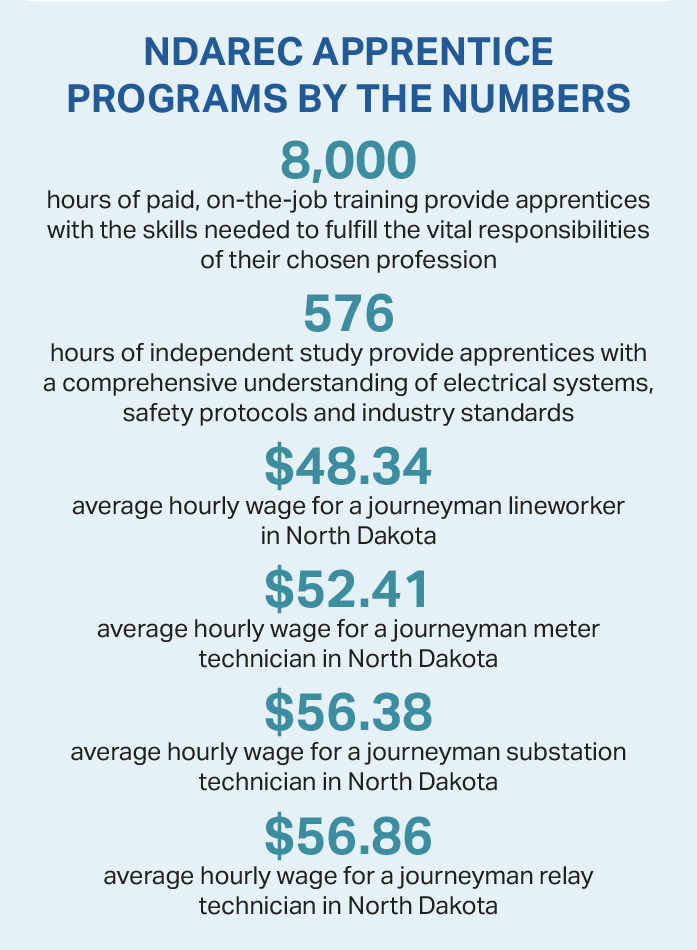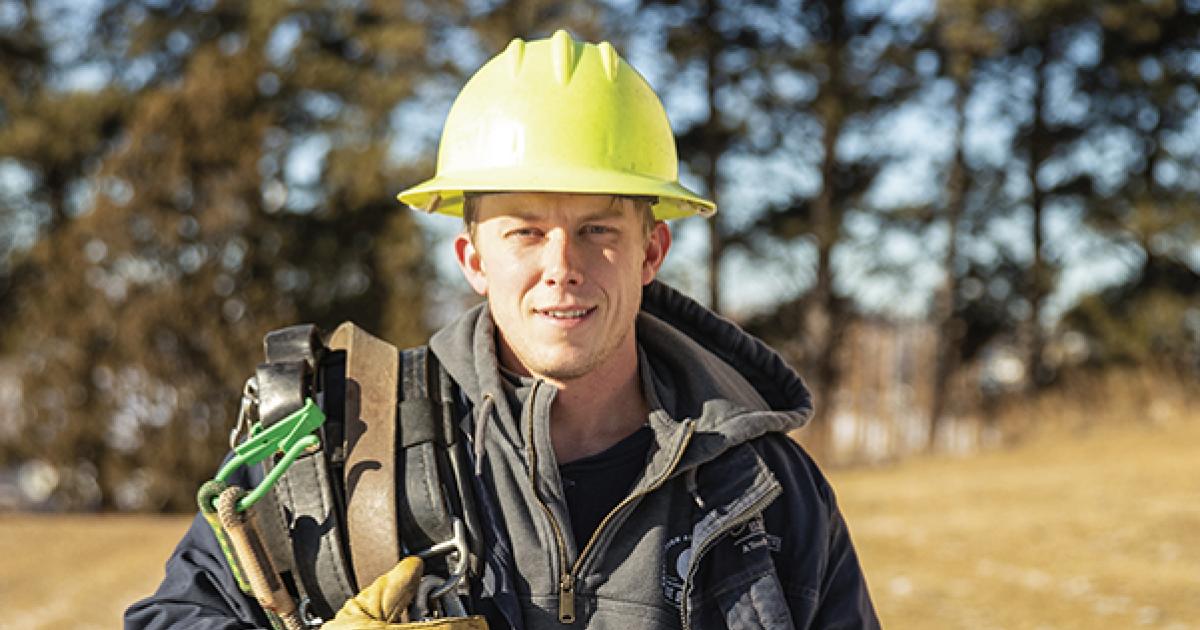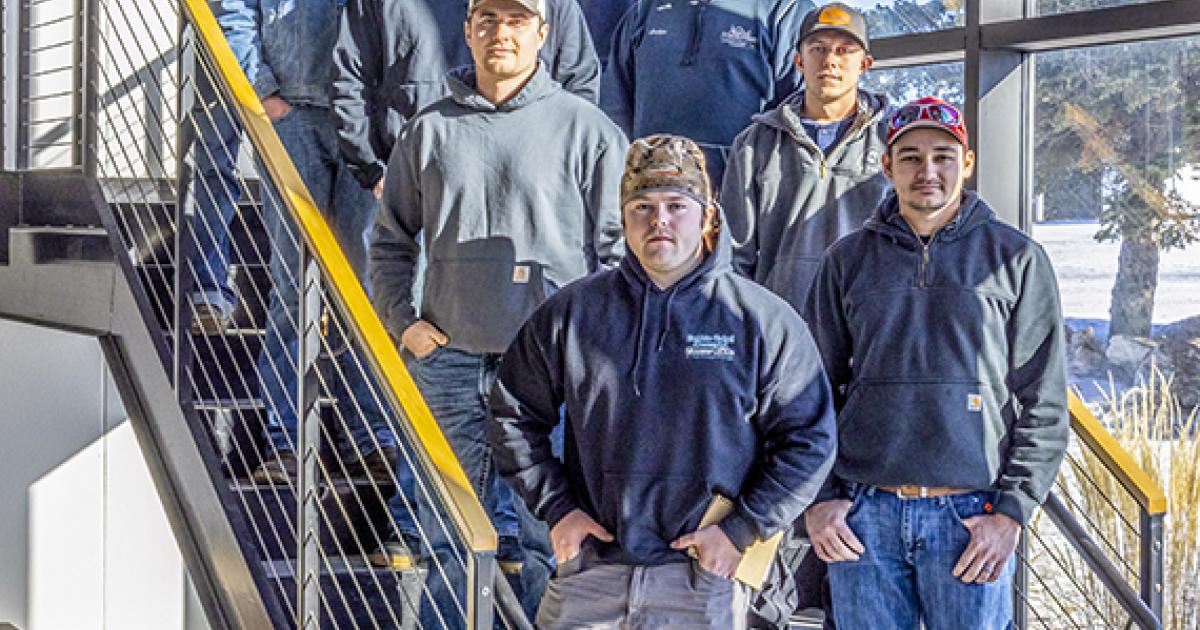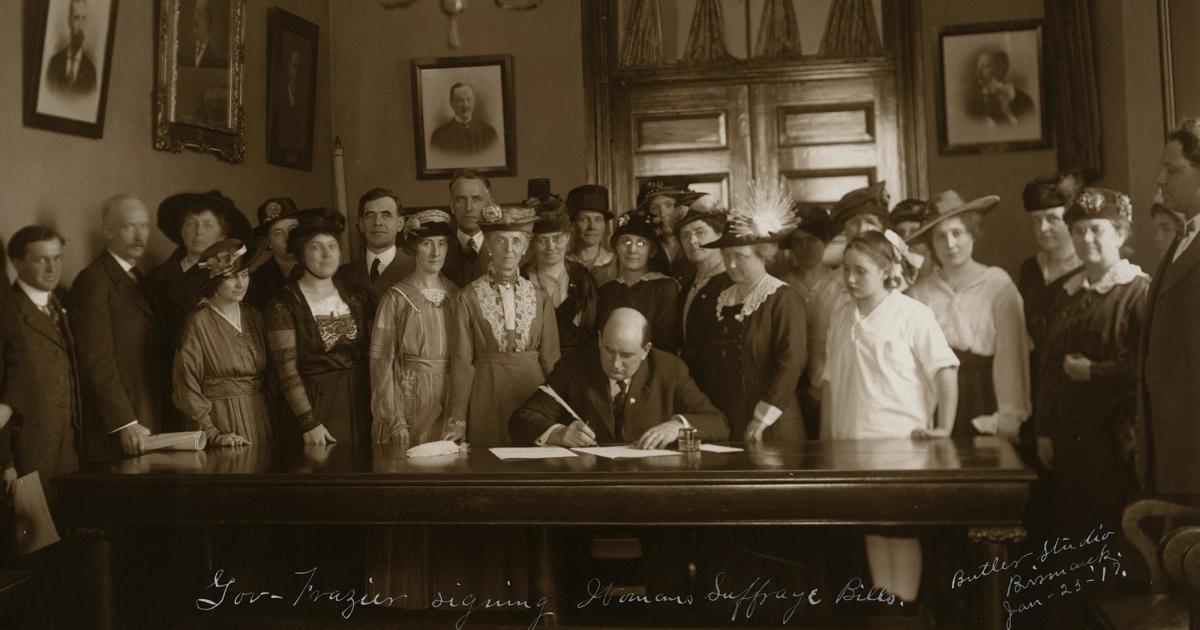Apprentice programs help develop crucial workforce
Before gaining journeyman lineworker status, Jacob Lund earned while he learned through participation in a lineworker apprenticeship program. Photo by NDAREC/Kennedy DeLap
 High above the ground with a sweeping view of the North Dakota prairie is right where Jacob Lund is meant to be.
High above the ground with a sweeping view of the North Dakota prairie is right where Jacob Lund is meant to be.
As a journeyman lineworker, Lund is often 35 feet in the air, working on the high-voltage electrical infrastructure that powers the lives of his cooperative’s members. And there’s no place he’d rather be.
“I chose the profession because it was outdoors,” Lund says. “Even on cold days, I appreciate being outside.”
Lund’s decision to take his future to new heights began in 2019, when he enrolled in the electrical lineworker program at Northwest Lineman College in Meridian, Idaho. Throughout the 15-week pre-apprenticeship program, he learned the skills needed to begin his journey toward his future trade.
Lund then accepted an apprentice lineworker position at Nodak Electric Cooperative and enrolled in the North Dakota Association of Rural Electric Cooperatives’ (NDAREC) lineworker apprenticeship program. Over the next four years, he earned a quality wage while gaining the skills and knowledge needed to become a successful journeyman lineworker.
“School provided a lot of the basics, but I learned pretty much everything in my apprenticeship,” Lund says. “I feel very lucky to have worked on the crews I’ve been on. They were very knowledgeable and patient in teaching me.”
APPRENTICESHIP PROGRAMS
NDAREC’s lineworker apprenticeship program provides an opportunity for aspiring lineworkers to earn while they learn. Over the course of the apprenticeship, which typically lasts four years, apprentices work under the guidance of skilled journeymen lineworkers, who help them gain proficiency in 14 work process categories, including overhead and underground line construction and hotline maintenance, which requires working with energized power lines.
“It’s a good program,” says Apprentice Lineworker Justin Heller, Mountrail-Williams Electric Cooperative. “We have a dangerous job, and knowledge is key. At Mountrail-Williams, we have some older guys who are very good teachers. There’s always something to learn, and they’ll tell you that, too, even when you think you’re right!”
In addition to on-the-job training, lineworker apprentices must complete 576 hours of self-study to deepen their understanding of electrical systems, safety protocols and industry standards. The curriculum is divided among 40 books, each focused on a specific topic. This independent learning builds on the knowledge gained through pre-apprentice training programs, like Bismarck State College’s (BSC) 10-month lineworker program.
“They’re good books. It’s kind of like school, but they go a little more in-depth on the topics and subjects you learn, like substations and different techniques for building line,” Heller says. “Sometimes, you'll see something, and then you'll read about it in the book and think, ‘Oh, I understand it now.’ And the book will help you along.”
NDAREC’s apprenticeship programs, which stand as a testament to electric cooperatives’ commitment to the current and future workforce, can be traced back to the 1940s, when North Dakota’s electric cooperatives first brought power to the prairie.
“Recognizing the need for a skilled workforce to maintain the newly constructed infrastructure, North Dakota's electric cooperatives looked to NDAREC for help, and the statewide association answered their call,” says NDAREC Safety Director Christina Roemmich.
In 1948, the statewide association hired its first safety and job training instructor, who traveled across the state to provide on-the-job training to the existing workforce. Twenty years later, NDAREC established the lineworker apprentice program with the International Brotherhood of Electrical Lineworkers. And in 1970, the association partnered with BSC to launch a pre-apprenticeship lineworker training program. Today, most participants of NDAREC’s apprenticeship programs have completed the BSC foundational course.
This commitment to training has paved the way for future generations of lineworkers like Lund and Heller, who continue to embrace the challenges and rewards of this vital profession.
An evolving program
Over the years, NDAREC’s training programs have evolved to meet the growing demands of the energy sector and rapid advancements in technology.
In 2011, the association introduced its meter technician program. This program provides apprentices with the skills and knowledge necessary to install, maintain, repair and test electric utility meters, which are critical for accurately measuring and monitoring electricity consumption.
In 2025, NDAREC will add two new apprentice programs – the substation technician program and the relay technician program.
“The demand for substation and relay technicians is high, but there is a shortage of skilled professionals to fill these positions,” Roemmich says. “These new apprenticeship programs will address this challenge by providing an opportunity for cooperatives to build their workforce from within and ensure workers possess the skills to safely and effectively power the lives of their members.”
The substation technician program will train apprentices to work on the equipment and systems that control the flow of electricity within substations, which are critical components of the electrical grid. Substations step down high-voltage electricity to lower voltages that can be safely delivered to cooperative members.
“Through testing and maintenance, substation technicians can catch issues before they result in equipment failures or power outages,” says Substation Electrician Cody Vrem, Central Power Electric Cooperative. “A massive equipment failure, where you could lose a transformer or a regulator, could not only interrupt service, but also hurt somebody. The job of a substation technician is to catch the demons before they’re released.”
The relay technician program will train apprentices to install, maintain and test protective relay systems used in electrical power grids. These relays are essential for detecting faults and ensuring the safe and efficient operation of electrical systems.
“Relay technicians make sure everyone has the power to do the things they need to do. But they also protect people and equipment,” says Electrician Tom Magnuson, Central Power Electric Cooperative. “If a line hits the ground, it's supposed to be off. That’s the kind of protection relay technicians are responsible for building.”
By blending practical experience with technical education, these programs will prepare apprentices to thrive in two demanding yet rewarding fields.
Building tomorrow’s workforce
As the world’s reliance on electricity grows, so does the need for skilled professionals to meet this demand. NDAREC’s apprenticeship programs provide a pathway to rewarding and meaningful careers. For individuals with a passion for problem-solving, a dedication to safety and a drive to support their communities, these programs offer unparalleled opportunities to shape and power the future.
___
Krista Rausch is a communications specialist with NDAREC. She can be reached at krausch@ndarec.com.












